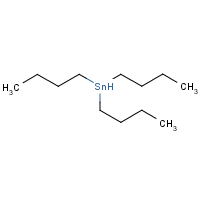Tri-n-butyltin hydride
Agent Name
Tri-n-butyltin hydride
Alternative Name
Tributyltin
CAS Number
688-73-3
Formula
C12-H28-Sn
Major Category
Metals

Synonyms
Stannane, tributyl-; Tin, tri-n-butyl-, hydride; Tri-n-butylstannane hydride; Tributylstannane; Tributylstannic hydride; Tributyltin; Tributyltin hydride; [ChemIDplus] UN2788
Category
Tin Compounds, Organic
Description
Liquid; [Hawley] Colorless liquid; [MSDSonline]
Sources/Uses
Used as a biocide in paints for ships and fishnets; [ChemIDplus] Used as a reducing agent for the conversion of alkyl halides to hydrocarbons, a veterinary anthelmintic for poultry, and an intermediate to make other butyltin compounds; Use as a marine biocide is being phased out globally due to toxicity to aquatic organisms. [HSDB]
Comments
In inhalation lethal dose studies, causes lacrimation, dyspnea, and seizures; [ChemIDplus] Can cause skin burns; [Sullivan, p. 979] A skin and eye irritant; [eChemPortal: ERMA] Produces flammable gases on contact with water; An irritant; Can be absorbed through skin; [MSDSonline] See "ORGANOMETALS." See "Tin, organic compounds."
Reference Link #1
Biomedical References
Exposure Assessment
Skin Designation (ACGIH)
Yes
TLV (ACGIH)
0.1 mg/m3, as Sn
STEL (ACGIH)
0.2 mg/m3, as Sn
PEL (OSHA)
0.1 mg/m3, as Sn
MAK
0.02 mg/m3, inhalable fraction, as Sn
IDLH (NIOSH)
25 mg/m3, as Sn
Lethal Concentration
LCLo (rat) = 1,460 mg/m3/10min
Explanatory Notes
The Guide in the Emergency Response Guidebook is for "Organotin compound, liquid, n.o.s." Organic tin compounds have a "skin" designation and are classified as "A4" (Not classifiable as human carcinogen); [ACGIH]
Adverse Effects
Neurotoxin
Other CNS neurotoxin
Hepatotoxin
Hepatoxic (a) from occupational exposure (secondary effect) or (b) in animal studies or in humans after ingestion
Dermatotoxin
Skin burns
ACGIH Carcinogen
Not Classifiable
Diseases, Processes, and Activities Linked to This Agent
Processes
Industrial Processes with risk of exposure: